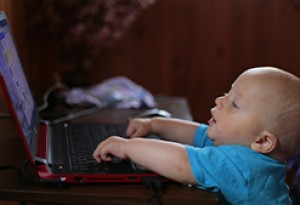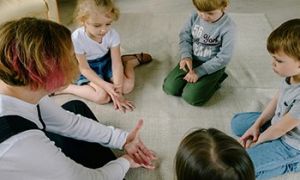Quality Area 5 of the National Quality Standard focuses on educators developing responsive, warm, trusting and respectful relationships with children that promote their wellbeing, self-esteem, sense of security and belonging. Relationships of this kind encourage children to explore the environment and engage in play and learning.
When educational leaders, co-ordinators and educators take a positive, strengths-based approach to guiding children’s behaviour, they ultimately empower children to regulate their own behaviour and develop the skills needed to interact and negotiate effectively with others.
Each standard and element is represented by outcomes that contribute to the standard being achieved within the service. The following is a list of outcomes under each element within QA5, that can help services identify if they are achieving Quality Area 5. It also includes documentation to support each element. This list can be used as a guide for Self-Assessment purposes and the development of the Quality Improvement Plan.
5.1 – Respectful and equitable relationships are maintained with each child.
5.1.1 Responsive and meaningful interactions build trusting relationships which engage and support each child to feel secure, confident and included.
This can be achieved by:
• sitting and engaging in relaxed and unhurried two-way conversations with children, particularly at mealtimes
• assisting new children to settle into the program by talking with them or their families about their interests
• responding openly, positively and respectfully to children’s comments, questions and requests for assistance
• engaging with children in conversations throughout the day or session, talking about what is happening around them and what they are learning
• engaging in sustained conversations with each child about their individual interests
• showing enthusiasm and respect when interacting with all children and their families
• comforting children who cry or show other signs of distress
• responding positively to the varying abilities, individual strengths and confidence of all children, and facilitating their involvement in the service
• acknowledging children’s efforts and achievements and supporting children to experience success
• adjusting and tailoring their interactions to best support the different ages and capabilities of children attending the service
• demonstrating that they know each child well and have developed a unique, reciprocal relationship with each child
• actively supporting the maintenance of each child’s home language where interactions with the family support this approach
• respectfully participating in children’s play and using children’s cues to guide their level and type of involvement
• modelling reasoning, predicting, reflective processes and appropriate language
• collaborating with children about routines and experiences and providing opportunities for them to make decisions and choices
• using appropriate techniques, such as sign language and other resources and tools, to support communication with all children
Documentation to support this includes:
• examples of information gathered from - families to support their child during the settling-in process, other professionals or support agencies that work with children, including children who require additional support and those from culturally and linguistically diverse backgrounds
• the service’s approach to equity and inclusion, documented in the statement of philosophy
• plans for the inclusion of children who require additional support
• evidence that educators and co-ordinators draw on the diverse knowledge, experiences and views of their colleagues when reviewing their teaching strategies and experiences planned for children, to ensure that all children have opportunities to achieve learning outcomes 236
• evidence of planned and spontaneous experiences and routines where educators support the engagement of individual children and groups of children in experiences of their own choosing
• documentation of children’s learning that shows evidence that educators’ interactions with children are used to support children’s developing ideas, skills and relationships
5.1.2 The dignity and rights of every child are maintained.
This can be achieved by:
• spaces, resources and routines arranged to minimise times when children are likely to experience stress or frustration or made to wait unnecessarily
• children supported to make choices and to experience the consequences of these where there is no risk of harm to themselves or another person
• children being acknowledged when they make positive choices in managing their own behaviour
• children speaking in comforting tones and holding babies to soothe them when they are crying
• using distraction and redirection techniques when children want the same toy or are distressed
• responding positively to children’s exploratory behaviour
• responding to their own children’s behaviour and the behaviour of children using the service in a fair and consistent way
Documentation to support this include:
• documentation that shows that diverse views, including family backgrounds and values, are considered in planning and programming for each child
• the United Nations Convention on the Rights of the Child displayed
• documented reflections on children’s experiences at the service including whether all children’s rights are being upheld
5.2 – Each child is supported to build and maintain sensitive and responsive relationships.
5.2.1 – Children are supported to collaborate, learn from and help each other.
This can be achieved by:
• children participating in play and showing awareness and interest in others
• children developing friendships as part of a small group
• children engaging in enjoyable interactions with their peers, contributing to shared
• children engaged in experiences that support them in establishing and maintaining relationships with children of various ages, genders, cultures and capabilities
• children engaged in ongoing collaborative projects they have initiated that involves research, planning, problem-solving and shared decision-making
• children engaged in activities that may benefit others (such as helping re-set experiences or setting the table for a meal)
• children showing kindness and compassion towards their peers
• children negotiating roles and relationships in play and leisure experiences
• children spending time with their peers
• supporting children’s progress through different stages of play, to help them gain confidence in interacting with their peers
• modelling collaborative behaviour through their interactions with children and colleagues, to help children to initiate interactions and join in play and social experiences with their peers
• respectfully and thoughtfully engaging in children’s group play and projects
• supporting children to understand or communicate with each other
• planning experiences that encourage children to work together to achieve success
• allocating time for relaxed, unhurried experiences that enable children to collaborate and direct their own learning together
• creating opportunities for peer scaffolding in small and large group play
• asking follow-up questions to extend children’s learning in group situations
• promoting a sense of community in the service
• providing opportunities and resources for children to assume leadership roles and direct play experiences with their peers
• acknowledging older children’s complex relationships and sensitively intervening in ways that promote social inclusion
Documentation to support this includes:
• the service’s policy on interactions with children and behaviour guidance
• evidence that the program and routines include regular opportunities for children to engage in social play and collaborative experiences, educators identify children’s shared interests and use this information to plan
• further collaborative learning opportunities
• the program includes collaborative and challenging learning experiences that are responsive to children’s interests
5.2.2 – Each child is supported to regulate their own behaviour, respond appropriately to the behaviours of others and communicate effectively to resolve conflicts.
This can be achieved by:
• children engaging in cooperative, helping behaviour
• exploring different identities and points of view in dramatic play
• children challenging other children’s behaviour when it is disrespectful or unfair
• children expressing their feelings and responses to others’ behaviours confidently and constructively
• children being supported to communicate effectively to resolve disagreements with others
• implementing planned and spontaneous discussions about emotions, feelings and issues of inclusion and exclusion, fair and unfair behaviour, bias and prejudice
• modelling respectful behaviour and providing supportive language to enable children to vocalise their concerns
• encouraging children to listen to other children’s ideas, consider alternative behaviours and solve problems together
• talking with children about the outcomes of their actions, and the rules and reasons for these
• planning and implementing strategies to support individual children’s behaviour
• discussing with and supporting children to identify their feelings, and providing a safe place for them to explore calming strategies
• listening empathetically to children when they express their emotions, acknowledging their feelings and reassuring children that it is normal to experience positive and negative emotions at times
• supporting children to negotiate their rights in relation to the rights of others and intervening sensitively when children experience difficulty in resolving a disagreement
Documentation to support this includes:
• the service’s policies and procedures on interactions with children and behaviour guidance
• planned and spontaneous experiences that support children to develop and practise the skills required to participate in group discussions and
• negotiate shared decision-making with their peers
• collaboration with schools, other professionals or support agencies that
• work with children who have diagnosed behavioural or social difficulties
• examples of information gathered from families about their children’s social skills and relationship preferences
• documented communication with families that shows their views, ideas and preferences have been considered when planning appropriate strategies to support their child’s positive inclusion in the program
• the service’s policy on interactions with children that outlines a clear process for guiding children’s behaviour, based on current recognised approaches and with a focus on children’s rights
• individual behaviour guidance plans for children, including evidence of consultation with their families and if appropriate, input and suggestions from other professionals and support agencies
Please note that this is to be used as a general guideline only. Please read the Guide To The NQS for more detailed information of what is required for each standard.
Reference:
New Guide To The National Quality Framework, Australian Children’s Education and Care Quality Authority.







 Here is the list of the EYLF Learning Outcomes that you can use as a guide or reference for your documentation and planning. The EYLF
Here is the list of the EYLF Learning Outcomes that you can use as a guide or reference for your documentation and planning. The EYLF The EYLF is a guide which consists of Principles, Practices and 5 main Learning Outcomes along with each of their sub outcomes, based on identity,
The EYLF is a guide which consists of Principles, Practices and 5 main Learning Outcomes along with each of their sub outcomes, based on identity, This is a guide on How to Write a Learning Story. It provides information on What Is A Learning Story, Writing A Learning Story, Sample
This is a guide on How to Write a Learning Story. It provides information on What Is A Learning Story, Writing A Learning Story, Sample One of the most important types of documentation methods that educators needs to be familiar with are “observations”. Observations are crucial for all early childhood
One of the most important types of documentation methods that educators needs to be familiar with are “observations”. Observations are crucial for all early childhood To support children achieve learning outcomes from the EYLF Framework, the following list gives educators examples of how to promote children's learning in each individual
To support children achieve learning outcomes from the EYLF Framework, the following list gives educators examples of how to promote children's learning in each individual Reflective practice is learning from everyday situations and issues and concerns that arise which form part of our daily routine while working in an early
Reflective practice is learning from everyday situations and issues and concerns that arise which form part of our daily routine while working in an early Within Australia, Programming and Planning is reflected and supported by the Early Years Learning Framework. Educators within early childhood settings, use the EYLF to guide
Within Australia, Programming and Planning is reflected and supported by the Early Years Learning Framework. Educators within early childhood settings, use the EYLF to guide When observing children, it's important that we use a range of different observation methods from running records, learning stories to photographs and work samples. Using
When observing children, it's important that we use a range of different observation methods from running records, learning stories to photographs and work samples. Using This is a guide for educators on what to observe under each sub learning outcome from the EYLF Framework, when a child is engaged in
This is a guide for educators on what to observe under each sub learning outcome from the EYLF Framework, when a child is engaged in The Early Years Learning Framework describes the curriculum as “all the interactions, experiences, activities, routines and events, planned and unplanned, that occur in an environment
The Early Years Learning Framework describes the curriculum as “all the interactions, experiences, activities, routines and events, planned and unplanned, that occur in an environment


